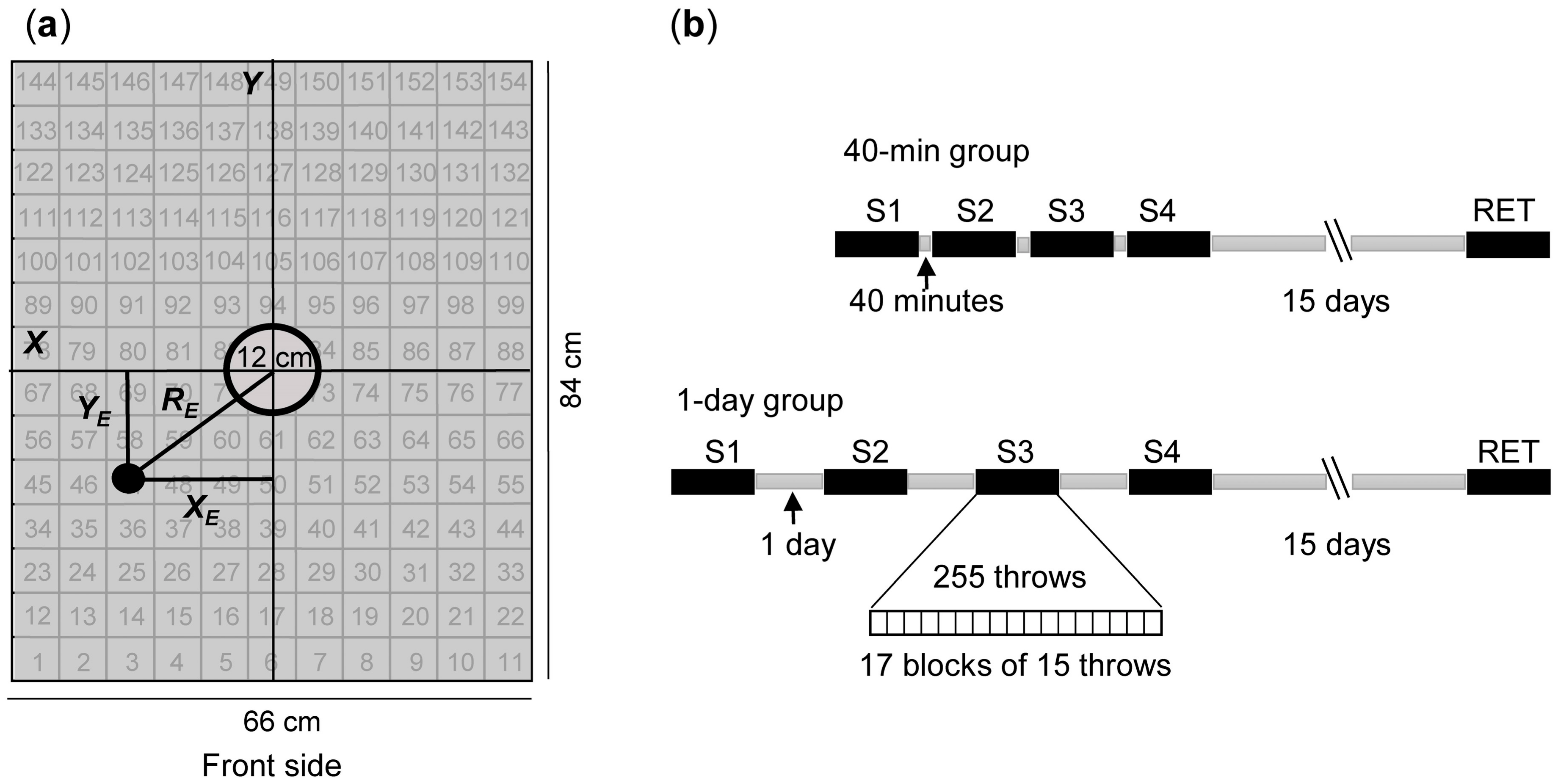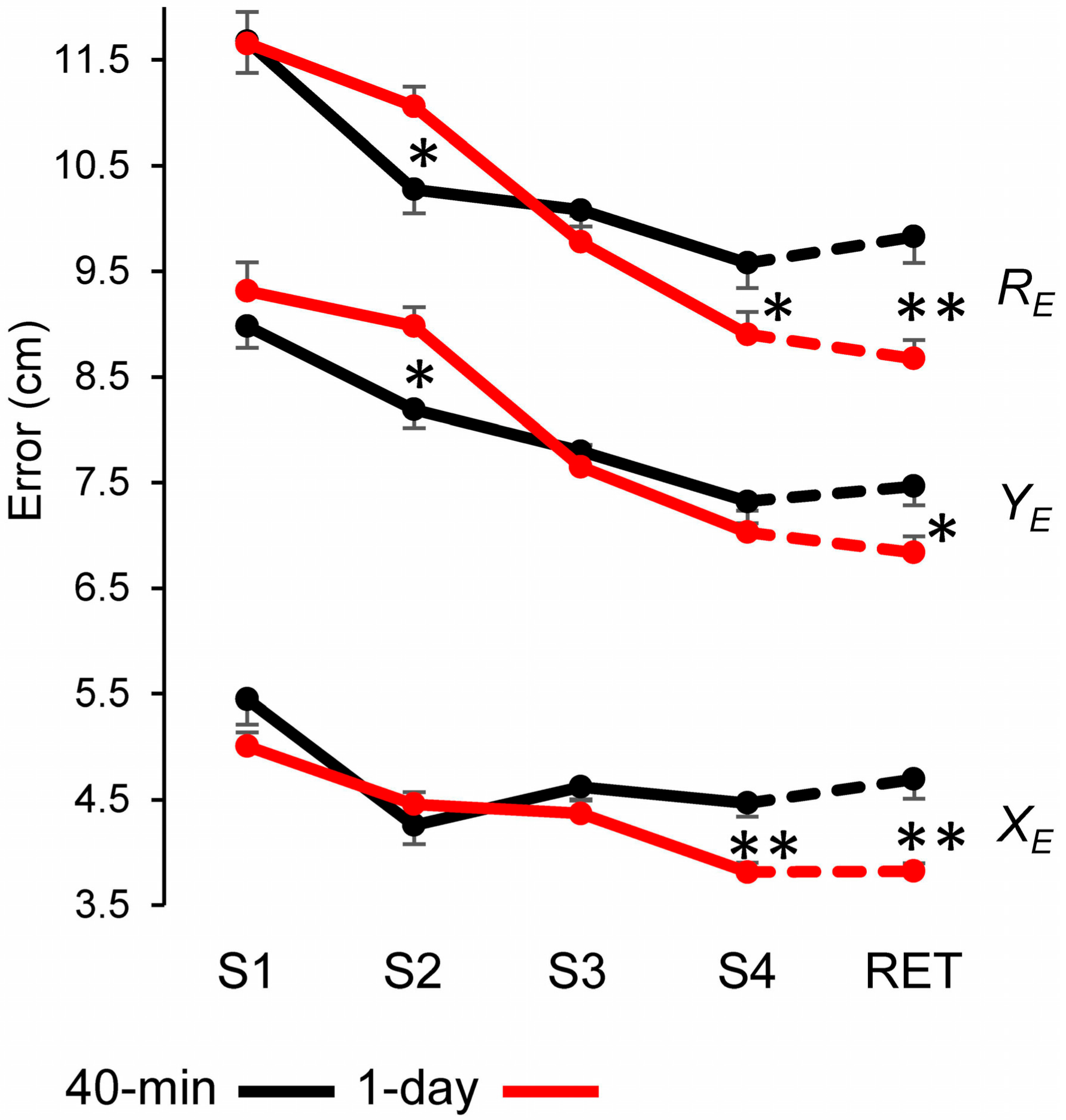Delayed Benefits from Spaced Training When Learning a Precision Throwing Task
Abstract
Featured Application
Abstract
1. Introduction
2. Materials and Methods
2.1. Participants
2.2. Apparatus and Procedures
2.3. Measurements
2.4. Statistical Analysis
3. Results
3.1. Overall Effect of Spaced Practice on Learning and Memory Retention
3.2. Contribution of Directional Components on the Performance
3.3. Within-Session Changes Associated with Spaced Practice
4. Discussion
4.1. Amount of Practice and Offline Gain
4.2. Initial Decrement of the Performance within the Sessions
5. Conclusions
Author Contributions
Funding
Acknowledgments
Conflicts of Interest
References
- Pekny, S.E.; Shadmehr, R. Optimizing effort: Increased efficiency of motor memory with time away from practice. J. Neurophysiol. 2015, 113, 445–454. [Google Scholar] [CrossRef] [PubMed]
- Robertson, E.M.; Pascual-Leone, A.; Miall, R.C. Current concepts in procedural consolidation. Nat. Rev. Neurosci. 2004, 5, 576–582. [Google Scholar] [CrossRef] [PubMed]
- Verhoeven, F.M.; Newell, K.M. Unifying practice schedules in the timescales of motor learning and performance. Hum. Mov. Sci. 2018, 59, 153–169. [Google Scholar] [CrossRef] [PubMed]
- Robertson, E.M. From creation to consolidation: A novel framework for memory processing. PLoS Biol. 2009, 7, e19. [Google Scholar] [CrossRef] [PubMed]
- Sami, S.; Robertson, E.M.; Miall, R.C. The time course of task-specific memory consolidation effects in resting state networks. J. Neurosci. 2014, 34, 3982–3992. [Google Scholar] [CrossRef] [PubMed]
- Smolen, P.; Zhang, Y.; Byrne, J.H. The right time to learn: Mechanisms and optimization of spaced learning. Nat. Rev. Neurosci. 2016, 17, 77–88. [Google Scholar] [CrossRef] [PubMed]
- Brashers-Krug, T.; Shadmehr, R.; Bizzi, E. Consolidation in human motor memory. Nature 1996, 382, 252–255. [Google Scholar] [CrossRef] [PubMed]
- Aziz, W.; Wang, W.; Kesaf, S.; Mohamed, A.A.; Fukazawa, Y.; Shigemoto, R. Distinct kinetics of synaptic structural plasticity, memory formation, and memory decay in massed and spaced learning. Proc. Natl. Acad. Sci. USA 2014, 111, E194–E202. [Google Scholar] [CrossRef] [PubMed]
- Press, D.Z.; Casement, M.D.; Pascual-Leone, A.; Robertson, E.M. The time course of off-line motor sequence learning. Brain Res. Cogn. Brain Res. 2005, 25, 375–378. [Google Scholar] [CrossRef] [PubMed]
- Shadmehr, R.; Holcomb, H.H. Neural correlates of motor memory consolidation. Science 1997, 277, 821–825. [Google Scholar] [CrossRef] [PubMed]
- Hauptmann, B.; Reinhart, E.; Brandt, S.A.; Karni, A. The predictive value of the levelling off of within session performance for procedural memory consolidation. Cogn. Brain Res. 2005, 24, 181–189. [Google Scholar] [CrossRef] [PubMed]
- Valle, M.S.; Lombardo, L.; Cioni, M.; Casabona, A. Relationship between accuracy and complexity when learning underarm precision throwing. Eur. J. Sport. Sci. 2018, 18, 1217–1225. [Google Scholar] [CrossRef] [PubMed]
- Faul, F.; Erdfelder, E.; Lang, A.G.; Buchner, A. G*Power 3: A flexible statistical power analysis program for the social, behavioral, and biomedical sciences. Behav. Res. Methods 2007, 39, 175–191. [Google Scholar] [CrossRef] [PubMed]
- Casabona, A.; Valle, M.S.; Cavallaro, C.; Castorina, G.; Cioni, M. Selective improvements in balancing associated with offline periods of spaced training. Sci. Rep. 2018, 8, 7836. [Google Scholar] [CrossRef] [PubMed]
- Krakauer, J.W. Motor learning and consolidation: The case of visuomotor rotation. Adv. Exp. Med. Biol. 2009, 629, 405–421. [Google Scholar] [CrossRef] [PubMed]
- Donovan, J.J.; Radosevich, D.J. A meta-analytic review of the distribution of practice effect: Now you see it, now you don’t. J. Appl. Psychol. 1999, 84, 795–805. [Google Scholar] [CrossRef]
- Kording, K.P.; Tenenbaum, J.B.; Shadmehr, R. The dynamics of memory as a consequence of optimal adaptation to a changing body. Nature Neurosci. 2007, 10, 779–786. [Google Scholar] [CrossRef] [PubMed]
- Korman, M.; Raz, N.; Flash, T. Multiple shifts in the representation of a motor sequence during the acquisition of skilled performance. Proc. Natl. Acad. Sci. USA 2003, 100, 12492–12497. [Google Scholar] [CrossRef] [PubMed]
- Albouy, G.; Fogel, S.; Pottiez, H.; Nguyen, V.A.; Ray, L.; Lungu, O.; Doyon, J. Daytime sleep enhances consolidation of the spatial but not motoric representation of motor sequence memory. PLoS ONE 2013, 8, e52805. [Google Scholar] [CrossRef] [PubMed]
- Cohen, D.A.; Robertson, E.M. Motor sequence consolidation: Constrained by critical time windows or competing components. Exp. Brain Res. 2007, 177, 440–446. [Google Scholar] [CrossRef] [PubMed]
- Friedman, J.; Korman, M. Offline Optimization of the Relative Timing of Movements in a Sequence Is Blocked by Retroactive Behavioral Interference. Front. Hum. Neurosci. 2016, 10, 623. [Google Scholar] [CrossRef] [PubMed]
- Ajemian, R.; D’Ausilio, A.; Moorman, H.; Bizzi, E. Why professional athletes need a prolonged period of warm-up and other peculiarities of human motor learning. J. Mot. Behav. 2010, 42, 381–388. [Google Scholar] [CrossRef] [PubMed]
- Albert, S.T.; Shadmehr, R. The Neural Feedback Response to Error as a Teaching Signal for the Motor Learning System. J. Neurosci. 2016, 36, 4832–4845. [Google Scholar] [CrossRef] [PubMed]
- Keetch, K.M.; Schmidt, R.A.; Lee, T.D.; Young, D.E. Especial skills: Their emergence with massive amounts of practice. J. Exp. Psychol. Hum. Percept. Perform. 2005, 31, 970–978. [Google Scholar] [CrossRef] [PubMed]



© 2018 by the authors. Licensee MDPI, Basel, Switzerland. This article is an open access article distributed under the terms and conditions of the Creative Commons Attribution (CC BY) license (http://creativecommons.org/licenses/by/4.0/).
Share and Cite
Casabona, A.; Lombardo, L.; Cioni, M.; Valle, M.S. Delayed Benefits from Spaced Training When Learning a Precision Throwing Task. Appl. Sci. 2018, 8, 2359. https://doi.org/10.3390/app8122359
Casabona A, Lombardo L, Cioni M, Valle MS. Delayed Benefits from Spaced Training When Learning a Precision Throwing Task. Applied Sciences. 2018; 8(12):2359. https://doi.org/10.3390/app8122359
Chicago/Turabian StyleCasabona, Antonino, Luciano Lombardo, Matteo Cioni, and Maria Stella Valle. 2018. "Delayed Benefits from Spaced Training When Learning a Precision Throwing Task" Applied Sciences 8, no. 12: 2359. https://doi.org/10.3390/app8122359
APA StyleCasabona, A., Lombardo, L., Cioni, M., & Valle, M. S. (2018). Delayed Benefits from Spaced Training When Learning a Precision Throwing Task. Applied Sciences, 8(12), 2359. https://doi.org/10.3390/app8122359






